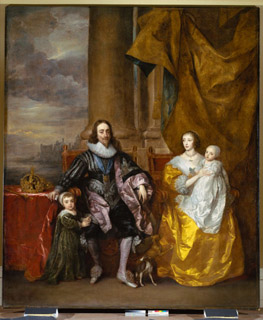Spare a thought for Daniel Mytens. In 1625 he was appointed “picture drawer ... to Charles I”. By the end of the decade, he was leading artist to the court of the King of England. Not bad for a first-generation immigrant, the son of a Dutch coach-builder. But in 1632 the wheels abruptly came off his carriage when a painter called Anthony Van Dyck, protege of Pieter Paul Rubens, came to London from Flanders. The contest of rivals soon came to a head. Mytens painted a competent if rather dull allegorical portrait of Charles I receiving a laurel wreath from his queen, Henrietta Maria. The King commissioned a second version of the same subject by Van Dyck and was so pleased with the result that he appointed him “principalle Paynter in Ordinary to their Majesties”. Van Dyck was knighted and given a house on the river at Blackfriars. Mytens, his reputation eclipsed, slipped quietly back to Holland and into the shadows of history
“Van Dyck in England”, a manageably medium-sized exhibition at Tate Britain, starts with work by such lesser lights of early seventeenth-century English art. Robert Peake’s Portrait of Princess Elizabeth, daughter of James I and Anne of Denmark, is a characteristically ornate example of the brittle late Mannerist style that prevailed in elite portraiture at the turn of the century. The solemn-faced ten-year-old girl, trapped in her lace ruff and minutely decorated silver-thread dress, looks as stiff as a playing-card queen. Mytens’ own portrait of Charles I, painted in 1628, is at least more convincingly human. The King wears an elaborate costume of maroon trimmed with gold ribbon and stands on a chessboard floor painted in textbook perspective. It is a sombre, sober, almost impressive picture, although its mannequin monumentality was soon be exposed by the incomparably...
“Van Dyck in England”, a manageably medium-sized exhibition at Tate Britain, starts with work by such lesser lights of early seventeenth-century English art. Robert Peake’s Portrait of Princess Elizabeth, daughter of James I and Anne of Denmark, is a characteristically ornate example of the brittle late Mannerist style that prevailed in elite portraiture at the turn of the century. The solemn-faced ten-year-old girl, trapped in her lace ruff and minutely decorated silver-thread dress, looks as stiff as a playing-card queen. Mytens’ own portrait of Charles I, painted in 1628, is at least more convincingly human. The King wears an elaborate costume of maroon trimmed with gold ribbon and stands on a chessboard floor painted in textbook perspective. It is a sombre, sober, almost impressive picture, although its mannequin monumentality was soon be exposed by the incomparably...


